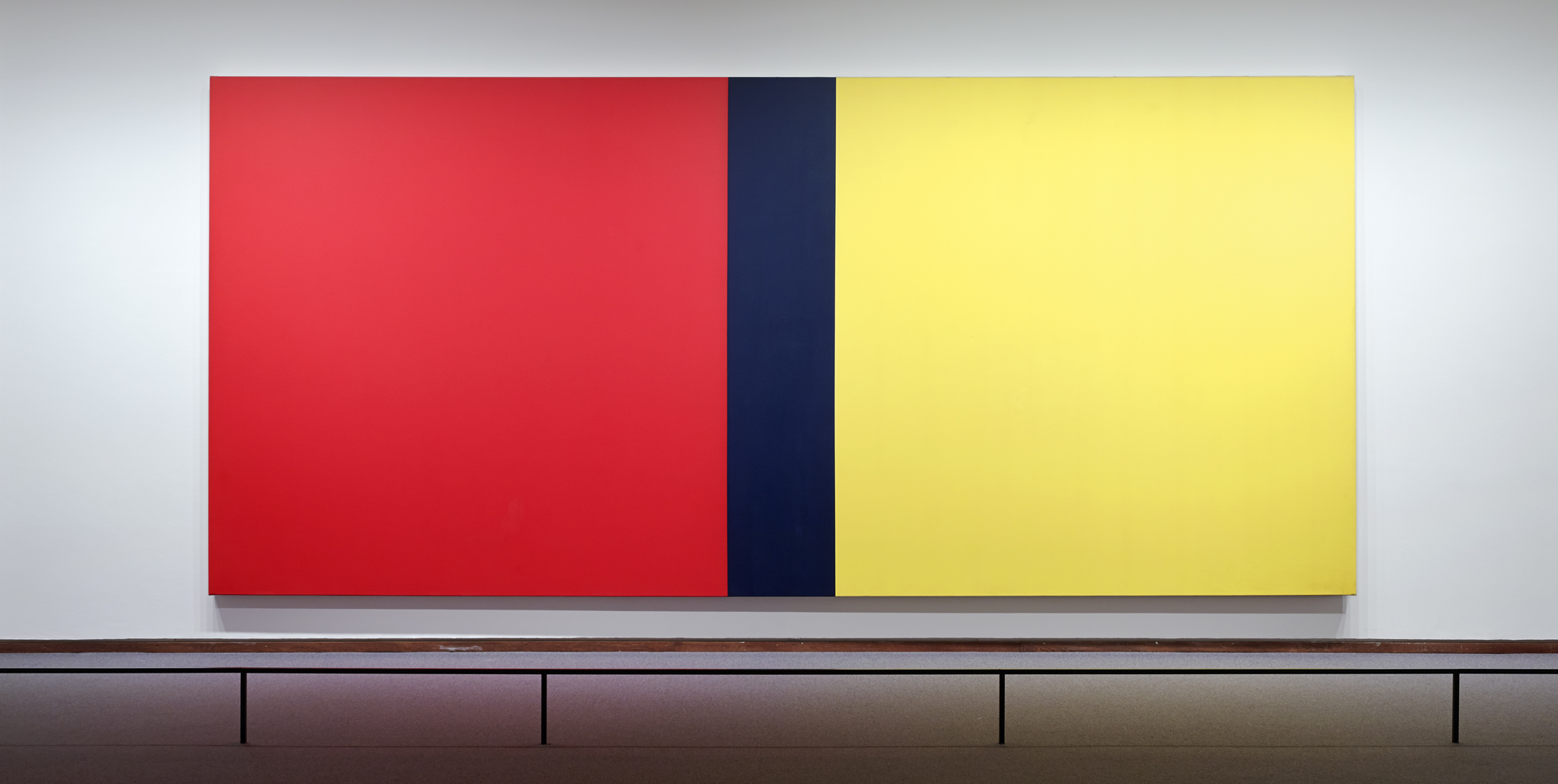Barnett Newman
Who's Afraid of Red, Yellow and Blue IV, 1969-70
Artist
Barnett Newman
Title
Who's Afraid of Red, Yellow and Blue IV
Year of creation
1969-70
Technique and dimensions
acrylic on canvas, 274.3 x 604, 5 cm
Year of acquisition
1982
Acquired with the Prussian Cultural Heritage Foundation
In the art-theoretical dialogue with Mondrian and in the examination of the "tragic" (Gottlieb, Rothko) and action painting (Pollock) in contemporary American art, the first version was created in 1966, the second version in 1967, 1966 /67 the III. version and in 1969/70 the fourth and final version of the picture sequence "Who's Afraid of Red, Yellow and Blue", which Barnett Newman completed before his death in 1970.
In the 1960s, these “big canvases” had an exemplary effect on the paintings of Donald Judd and Frank Stella. The painter summed up his fundamental color field problem "Red, Yellow and Blue" in 1969: "I began this picture, my first in the series Who's Afraid of Red, Yellow and Blue as a 'first picture', unprepared. I had the wish that the image should be asymmetrical, forming a space unlike any I had ever created, a kind of 'off-balance'. It was shortly after I had built the main red body that the color problem became crucial. only the colors yellow and blue were possible - At that moment I realized that I was confronted with the dogma that color must be reduced to the primary constellation. Just as I was confronted with other dogmatic positions of the purists, neoplasticists and other formalists with their dogma, which mortgaged red, yellow and blue by transforming these colors into an idea and thereby destroying them as colors. I therefore had the double incentive to use these very colors to express my intentions, they to use it more expressively than didactically and to free them from their mortgage. Why should anyone be afraid of red, yellow and blue?"
Over the course of a few years, Newman not only switched from portrait to landscape format of the canvases, he also increased their dimensions to an almost gigantic level. In the large Berlin version with its unsurpassed dimensions of 274 .3 x 604.5 cm, Newman decided on a basic compositional structure in which he stretched a narrow vertical, deep blue band in the middle between a red and yellow square. This dark perpendicular, also called "zip", divides, opens and clamps The adjacent, equally large colored squares in red and yellow on the frameless picture surface Newman's application of paint avoids any painterly brush marks; the opaque acrylic paints were applied in layers, so that a completely homogeneous surface was created, which also changes in the " "Outshine" of the three luminescent colors yellow and red constantly changes. Yellow and blue consist of one layer of color, while red consists of 17 layers on top of each other in order to intensify the contrasts and the harmony of the color surfaces with one another.
This monumental image is rigorously reduced to the primary colors red, yellow and blue; any association of representation has been completely erased. For Newman, the colors red, yellow and blue are defined in simultaneous contrast by their intensity and extent. Newman's color form is consistently brought to its final, final perfection in the fourth version: "In this epoch-making work, the structural symmetry balances the color asymmetry or the intensity of primary colors undermines the rigidity of the format. A painting that no longer aims to completely balance the "Who's Afraid of Red, Yellow and Blue IV makes the divergent evident at the same time as overcoming the image format." (Armin Second, 1997).
Newman's painting thus represents perhaps the absolute end point in the history of painting, a pictorial intention that is also ethically and philosophically based, in which the work exists autonomously for itself and at the same time only comes to life in the reception of the activated viewer: "The one stabilized by the blue in the picture Because of the red that is visually very close to him and the yellow that moves away from him, the viewer experiences himself as standing in the middle of the picture. He himself becomes the center of a color space that surrounds him. (Dieter Honisch, 1998). In this meditative "devotional picture" of the 20th century, which is unthinkable without the philosophy of the 19th and 20th centuries as well as the mystical tradition of the Jewish East, the viewer is challenged between the poles of closeness and distance and ultimately completely on his own referenced: "The Sublime is now" (Barnett Newman).
Barnett Newman's Who's Afraid of Red, Yellow and Blue IV was acquired from the artist's estate in 1982 through the extraordinary commitment of director Dieter Honisch with the support of the Association of Friends of the National Gallery. The acquisition, which was highly controversial in many quarters, was made amid massive public protests; the tabloid press defamed Newman's painting as the work of "an apprentice painter". They also didn't shy away from death threats towards Dieter Honisch.
In an exhibition tribute to Barnett Newman in 1982, 26 German artists each donated one of their works to the Association of Friends of the National Gallery. On April 13, 1982, Newman's picture of the century was severely damaged by an attack by a manic depressive veterinary student from Saarland. It was only in January 1985 that it was able to be hung again in the Mies van der Rohe building after a highly sensitive, successful restoration. Since then, amid American Colorfield's rotating presentations in various rooms, Barnett Newman's Who's Afraid of Red, Yellow and Blue IV has also remained the unsurpassed crowning image for the Dieter Honisch era at the Neue Nationalgalerie.
Roland March
